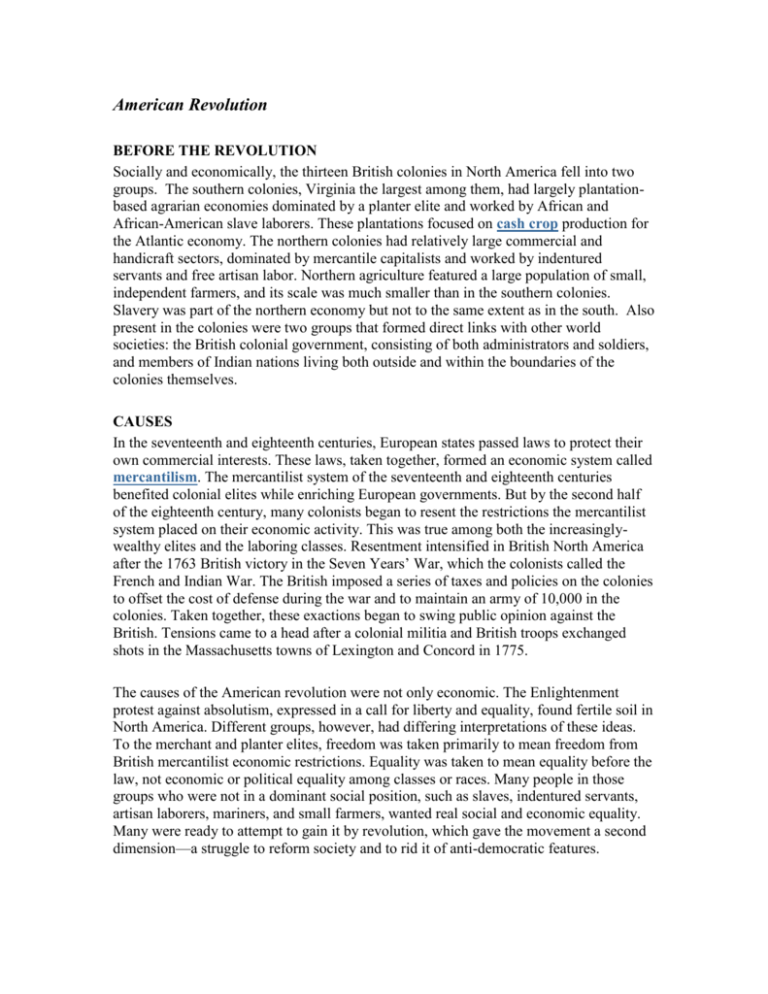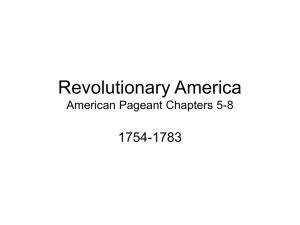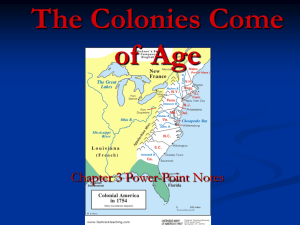American Revolution
advertisement

American Revolution BEFORE THE REVOLUTION Socially and economically, the thirteen British colonies in North America fell into two groups. The southern colonies, Virginia the largest among them, had largely plantationbased agrarian economies dominated by a planter elite and worked by African and African-American slave laborers. These plantations focused on cash crop production for the Atlantic economy. The northern colonies had relatively large commercial and handicraft sectors, dominated by mercantile capitalists and worked by indentured servants and free artisan labor. Northern agriculture featured a large population of small, independent farmers, and its scale was much smaller than in the southern colonies. Slavery was part of the northern economy but not to the same extent as in the south. Also present in the colonies were two groups that formed direct links with other world societies: the British colonial government, consisting of both administrators and soldiers, and members of Indian nations living both outside and within the boundaries of the colonies themselves. CAUSES In the seventeenth and eighteenth centuries, European states passed laws to protect their own commercial interests. These laws, taken together, formed an economic system called mercantilism. The mercantilist system of the seventeenth and eighteenth centuries benefited colonial elites while enriching European governments. But by the second half of the eighteenth century, many colonists began to resent the restrictions the mercantilist system placed on their economic activity. This was true among both the increasinglywealthy elites and the laboring classes. Resentment intensified in British North America after the 1763 British victory in the Seven Years’ War, which the colonists called the French and Indian War. The British imposed a series of taxes and policies on the colonies to offset the cost of defense during the war and to maintain an army of 10,000 in the colonies. Taken together, these exactions began to swing public opinion against the British. Tensions came to a head after a colonial militia and British troops exchanged shots in the Massachusetts towns of Lexington and Concord in 1775. The causes of the American revolution were not only economic. The Enlightenment protest against absolutism, expressed in a call for liberty and equality, found fertile soil in North America. Different groups, however, had differing interpretations of these ideas. To the merchant and planter elites, freedom was taken primarily to mean freedom from British mercantilist economic restrictions. Equality was taken to mean equality before the law, not economic or political equality among classes or races. Many people in those groups who were not in a dominant social position, such as slaves, indentured servants, artisan laborers, mariners, and small farmers, wanted real social and economic equality. Many were ready to attempt to gain it by revolution, which gave the movement a second dimension—a struggle to reform society and to rid it of anti-democratic features. RESULTS The American revolution produced freedom and equality but in terms most favorable to elite groups. Immediately after the revolutionaries’ victory in the war, the British army departed, and the new United States found itself outside of the British mercantilist system. After a brief experiment in a decentralized confederation, the Constitutional Convention of 1787 created a federation with a strong central government, shifting power from individual states to the national government. That national government, however, was an Enlightenment project, with separate legislative, executive, and judicial branches and elections built into the system. Racial inequality was built into the system as well. Despite the initial objections of some delegates to the conventions, a compromise allowed slaves to be counted as three-fifths of a person to determine the size of a state’s representation in the House of Representatives without allowing slaves to vote. However, northern states, through legislative and judicial decisions, gradually abolished slavery, and all but two states halted the importation of African slaves. The new United States shortly began to expand its borders. From the administration of George Washington forward, the United States moved to acquire Indian lands. This led to a series of treaties, broken treaties, and wars that would see the United States occupying North America from the Eastern seaboard to the West Coast by the mid-nineteenth century. Indian nations were pushed off ancestral lands and onto reservations, at the cost of many lives.









